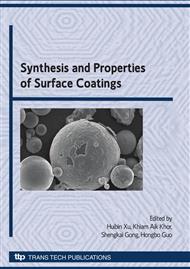p.1
p.7
p.13
p.19
p.25
p.31
p.37
Full-Scale Numerical Simulation of Plasma-Sprayed Functionally Gradient Materials
Abstract:
To develop novel and advanced thermal barrier coatings, full-scale numerical simulation of plasma-sprayed functionally gradient materials is conducted in this paper, including the prediction of basic parameters at the nozzle exit, simulation of three dimensional simulation of the plasma jet, modeling of the interaction between the plasma jet and the particles, calculation of flight trajectories and temperature history of flying metal and ceramic particles, the interaction between the molten particles and the substrate, as well as the deposition process of the coatings. Various complex phenomena, such as turbulent effects with chemical reactions in the plasma jet, dispersion status of the particles onto the substrate, and the composition distribution of the functionally gradient materials, are fully taken into account. The numerical simulation results are found to be in good agreement with experimental evidence.
Info:
Periodical:
Pages:
1-6
Citation:
Online since:
June 2009
Authors:
Price:
Сopyright:
© 2009 Trans Tech Publications Ltd. All Rights Reserved
Share:
Citation:


